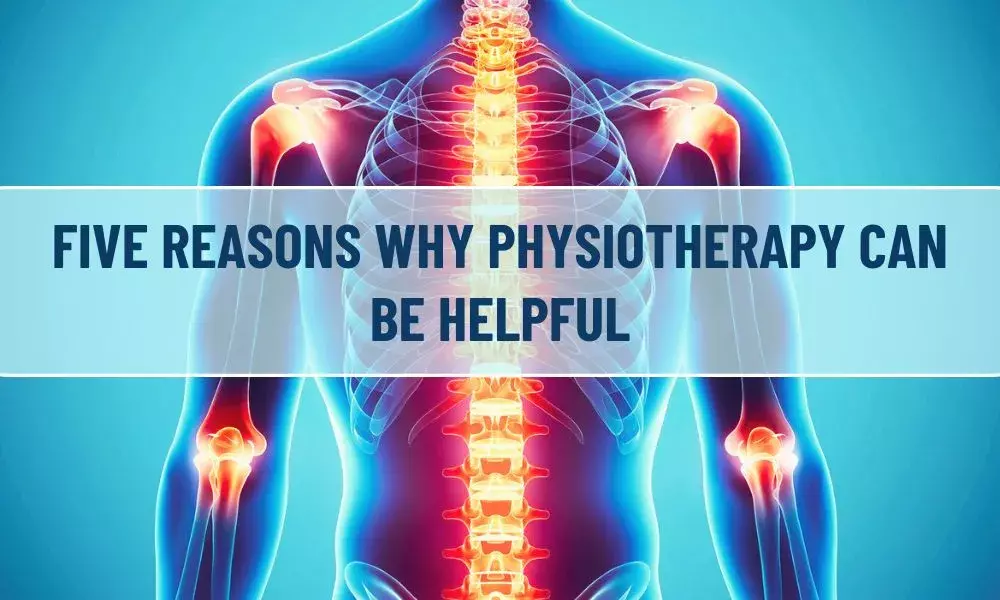September 8th every year is observed as World Physiotherapy Day. This day is dedicated to raising awareness about the significance of Physiotherapy (Physical therapy) in improving the overall health of people suffering from specific injuries, joint pain, and orthopedic or neurological conditions.
Table of Content
-
What is Physiotherapy?
-
Ailments in which Physiotherapy can be helpful
-
Types of Physiotherapy
-
5 Reasons why Physiotherapy can be a great help
-
Types of Treatment or Modalities used in Physiotherapy
What is Physiotherapy?
Physiotherapy is a line of treatment that helps restore movement and normal functioning of an individual affected by illness, injury, or disability. Physiotherapy is a branch of healthcare that diagnoses, assesses, treats and works to prevent disability. It is part of a complete fitness, health, and well-being plan.
Ailments in which Physiotherapy can be helpful
-
Joint pain, back and neck pain
-
Spinal cord injuries
-
Neurological disorders
-
Orthopedic concerns such as arthritis and amputated limbs
-
Disorders such as Parkinson’s and paralysis
-
General pain related to injuries, treatment, sports, or exercise.
-
Cardiovascular conditions like chronic heart disease or rehabilitation after a heart attack.
-
Respiratory issues such as asthma and obstructive pulmonary diseases.
-
Physiotherapy can be helpful for cancer patient’s post-surgery, especially in breast and mouth cancer cases.
Types of Physiotherapy
Physiotherapy has many types, but each addresses and treats a specific condition.
-
Pediatric physiotherapy treats infants and children.
-
Geriatric physiotherapy treats older adults who are ageing and experiencing discomfort in moving around.
-
Musculoskeletal physiotherapy (orthopedic physiotherapy) deals with treating and restoring any ailments related to the musculoskeletal system.
-
Neurological physiotherapy addresses conditions related to the nervous system. It deals with stroke, head and spinal cord injuries, diseases like Parkinson’s disease, sciatica, multiple sclerosis, etc.
-
Cardio-respiratory physiotherapy is useful for people with heart, chest, and lung diseases.
-
Female-centric physiotherapy deals with the female reproductive system and its various related issues. This type of physiotherapy helps provide pre-natal and post-natal care and makes the childbirth process easier.
-
Vestibular rehabilitation focuses on restoring the body’s balance and reduces any dizziness-related issues.
Physiotherapists use highly customized treatments to help people eliminate their pain. They also ensure that the pain does not come back in the future.
Five Reasons why Physiotherapy can be a great help
-
Pain Management
In case of chronic pain or pain resulting from an accident or injury, physiotherapy aids in pain management, improving the quality of our lives so that we can resume our daily activities, sports, and hobbies easily.
-
Improvement in movement
Physiotherapy helps improve the range of motion for those who have suffered an injury or have a condition affecting their basic movement. For example, stiffness and pain in our shoulder can lead to a case of frozen shoulder if we do not address and treat it. A proper physiotherapy plan can be of great help in such conditions.
-
Neurological Disorders
For patients who have suffered a stroke or have conditions such as Parkinson’s, physiotherapy plays a key role in correcting or improving the damage. Physiotherapy aims to bring back full or partial function and to stop further deterioration from taking place.
-
Exercise at ease in your home
Once a patient improves, certain exercises are prescribed to achieve further improvement. The best part of physiotherapy is one can continue the treatment in the comfort of their own house. However, the improvement is assessed from time to time by the physiotherapist. Sometimes, they may reduce the exercises if one faces difficulty and suggest other exercises.
-
Cardiopulmonary Conditions
Physiotherapy is a great option in case of breathing issues that may interfere with one’s day-to-day life. In physiotherapy, such patients improve greatly following guided exercises under the physiotherapist. Cardiac patients also receive instruction on basic movement to regain their confidence after surgery, making it easier to resume life smoothly post-surgery.
Types of Treatment or Modalities used in Physiotherapy
Manual therapy is a technique used by physiotherapists to manipulate and mobilize affected joints by massaging them with the use of their hands.
Transcutaneous electrical nerve stimulation (TENS) therapy is a technique wherein a small battery-driven device is used to send low-grade current through the electrodes placed on the skin surface. A TENS device temporarily relieves the pain of the affected area.
IFT ( Interferential Therapy) is one of the types of electrotherapy used for the management of pain.
Taping promotes the body’s natural healing process. A tape is used, which lifts the skin away from the connective tissue, hence increases the space and allows the lymphatic fluid to move more effectively.
Joint mobilization is a manual therapy technique is used wherein a physiotherapist mobilizes the joints at different speeds, depths, and amplitudes to restore normal joint movement.
Hydrotherapy utilizes water to treat arthritis. Specialized exercises are performed inside water with a temperature range of 33-36 degree Celsius under the guidance of a physiotherapist. It involves various stretching, aerobics, and strengthening exercises.
Hot and cold applications – Application of ice, cold packs, nitrogen spray, and techniques such as cryotherapy can relieve the patients from acute conditions. In cases of chronic conditions, physiotherapists use hot packs, infrared heat, diathermy, and ultrasonic waves.
Diathermy uses electrically induced heat or high-frequency electromagnetic currents to cure various conditions.
Therapeutic ultrasound uses the frequency range of 0.5 – 3 MHz. This technique helps in lowering down the inflammation by inducing a deep heat to a localized area to cure muscle spasms, promote healing at the cellular level, increase metabolism, and improve blood flow to the damaged tissue.
Phonophoresis is a technique which utilizes ultrasonic waves for effective absorption of the drugs which are topically applied. This technique has been found to be effective in relieving pain as it allows maximal absorption of drugs such as anti-inflammatory and analgesics.
Range of Motion (ROM) exercises are used to improve joint mobility and to decrease muscle stiffness.
Soft tissue mobilization or therapeutic massage helps in relaxing tight muscles, relieving pain, and reducing swelling.
Stretches and exercises. Physiotherapists teach various exercises and body stretching techniques, which help restore joint movements.
Rehabilitation. A wide range of strengthening, preventative, and corrective exercises are used to alleviate disease conditions.
Strengthening programs. Physiotherapists conduct specialized programs, such programs help patients in improving their overall strength, balance, coordination, and flexibility.
Physiotherapy plays a vital role in treating different health issues people may face at different age groups. It is a great method to heal the body and ensure that issues do not reoccur.




